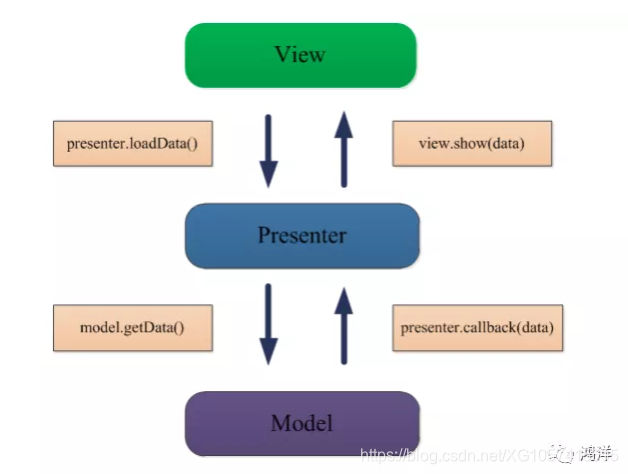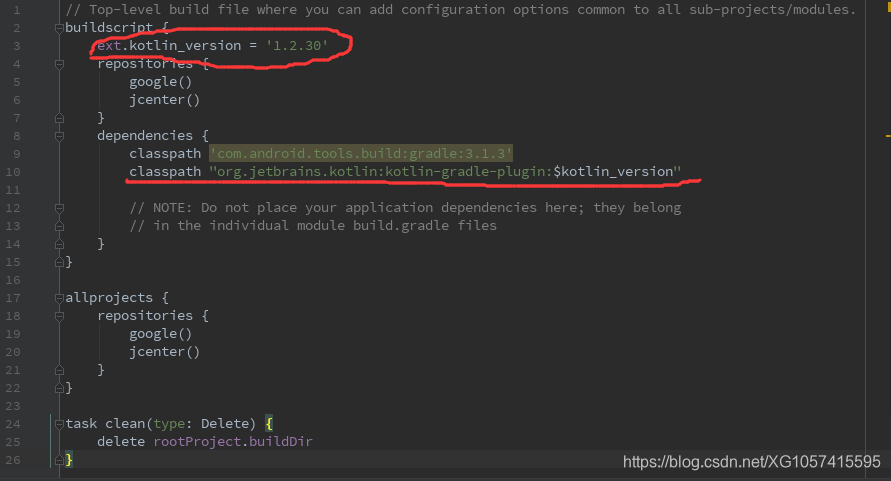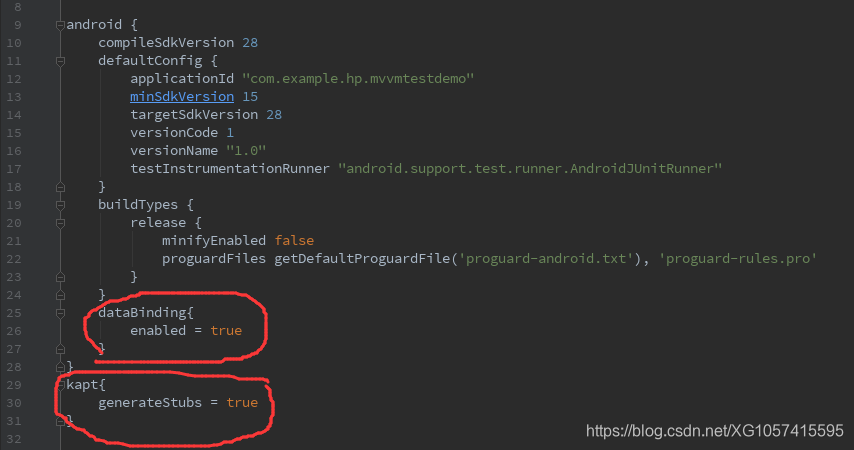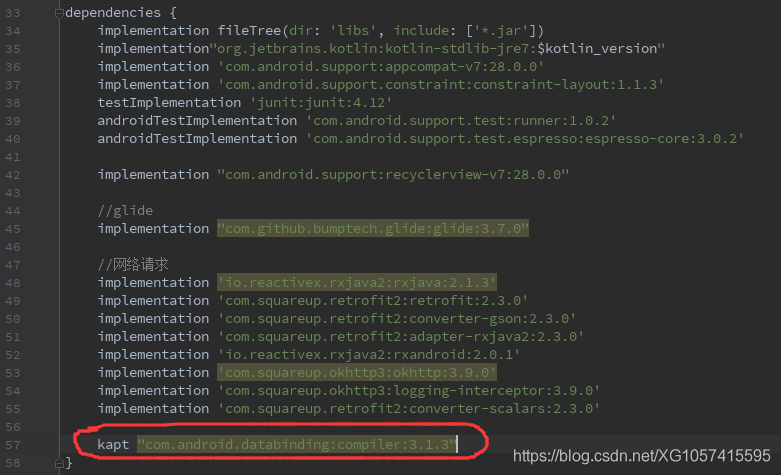最近学习MVVM模式,特此记录~~
本文目的:
①主要通过一个 MVVM的 Demo来了解一下我们在平时该怎么使用它
②对比 MVP和 MVVM的区别
好了,废话不多说~开始吧

首先我们来看一下 MVP和 MVVM的结构图:


图片来自https://mp.weixin.qq.com/s/PspA4DYPhzLtsJGJykGY0w
可以看出两者的区别并不大,MVP的 Presenter和 MVVM的 ViewModel扮演的角色一样,但是 MVP中 View层和 Presenter层是通过接口来连接的,所以我们通常需要大量的接口来完成 View层和 Presenter层的连接。而 MVVM中 View层和 ViewModel层是通过 DataBinding来连接的,从而减少了接口的使用。
MVP大家应该都很熟悉,这里我们直接通过一个MVVM的 Demo来演示。
这个 Demo用到了 Kotlin和 DataBinding,所以先要进行一些配置
在 project的 build.gradle需要添加 kotlin的配置

app模块下的 build.gradle



先看效果图

一个 Activity中放一个 Fragment,Fragment中只有一个 TextView和 RecyclerView,很简单~
先看一下目录结构

先看 MainActivity的 xml布局,外层是 layout,否则无法使用在Activity中无法使用DataBinding
<?xml version="1.0" encoding="utf-8"?>
<layout xmlns:android="http://schemas.android.com/apk/res/android"
xmlns:app="http://schemas.android.com/apk/res-auto"
xmlns:tools="http://schemas.android.com/tools">
<LinearLayout
android:layout_width="match_parent"
android:layout_height="match_parent"
android:orientation="vertical">
<FrameLayout
android:id="@+id/music_fragment"
android:layout_width="match_parent"
android:layout_height="match_parent"/>
</LinearLayout>
</layout>MainActivity.class只做了添加Fragment的操作
class MainActivity : AppCompatActivity() {
override fun onCreate(savedInstanceState: Bundle?) {
super.onCreate(savedInstanceState)
initView()
}
private fun initView() {
supportFragmentManager.beginTransaction().add(R.id.music_fragment,MusicFragment.getInstance()).commit()
}
}接下来看一下 MusicFragment的 xml布局,外层是 layout,包含 viewModel为 ViewModelFragment,加载数据失败时,会显示 “获取失败”的 TextView,该TextView的可见性由 ViewModel中的变量控制:
<?xml version="1.0" encoding="utf-8"?>
<layout xmlns:android="http://schemas.android.com/apk/res/android">
<data>
<variable
name="viewModel"
type="com.example.hp.mvvmtestdemo.viewmodel.ViewModelFragment"/>
</data>
<RelativeLayout
android:layout_width="match_parent"
android:layout_height="match_parent">
<TextView
android:id="@+id/search_word"
android:layout_width="match_parent"
android:layout_height="wrap_content"
android:text="@{viewModel.search_word}"
android:gravity="center_horizontal"
android:textSize="35sp"/>
<android.support.v7.widget.RecyclerView
android:id="@+id/recycler_view"
android:background="#ddd"
android:layout_width="match_parent"
android:layout_height="match_parent"
android:padding="8dp"
android:layout_below="@id/search_word">
</android.support.v7.widget.RecyclerView>
<LinearLayout
android:layout_width="match_parent"
android:id="@+id/error_info_layout"
android:orientation="vertical"
android:layout_height="match_parent">
<TextView
android:text="获取失败"
android:layout_gravity="center"
android:layout_width="wrap_content"
android:layout_height="wrap_content"
android:visibility="@{viewModel.errorInfoLayoutVisibility}"/>
</LinearLayout>
</RelativeLayout>
</layout>MusicFragment.class,主要得到 FragmentMusicBinding实例,在 onCreateView中返回 binding实例的 root,这个root表示布局的根;然后初始化 RecyclerView 和 ViewModel
class MusicFragment : Fragment() {
lateinit var fragmentBinding: FragmentMusicBinding
lateinit var viewModelFragment: ViewModelFragment
lateinit var adapter: MSongRecyclerAdapter
companion object {
val INSTANCE = MusicFragment()
fun getInstance():MusicFragment{
return INSTANCE
}
}
override fun onCreateView(inflater: LayoutInflater, container: ViewGroup?, savedInstanceState: Bundle?): View? {
// 通过 DataBindingUtil获得 binding实例
fragmentBinding = DataBindingUtil.inflate(inflater,R.layout.fragment_music,container,false)
initView()
return fragmentBinding.root
}
private fun initView() {
adapter = MSongRecyclerAdapter(context)
// 初始化 recyclerView
fragmentBinding.recyclerView.layoutManager = LinearLayoutManager(context,LinearLayoutManager.VERTICAL,false)
fragmentBinding.recyclerView.itemAnimator = DefaultItemAnimator()
fragmentBinding.recyclerView.adapter = adapter
//初始化 VewiModel
viewModelFragment = ViewModelFragment(adapter)
fragmentBinding.viewModel = viewModelFragment
}
}重点就是这里的 ViewModel了
class ViewModelFragment(adapter: MSongRecyclerAdapter) : BaseObservable(){
var adapter: MSongRecyclerAdapter = adapter
var search_word = ObservableField<String>("月光")
lateinit var errorInfoLayoutVisibility: ObservableField<Int>
init {
initData()
getSong()
}
private fun getSong() {
RetrofitFactory.provideBaiduApi()
.queryMerge(search_word.get(), 1, 50)
.subscribeOn(Schedulers.io())
.observeOn(AndroidSchedulers.mainThread())
.subscribe(object : Observer<QueryMergeResp> {
override fun onSubscribe(d: Disposable) {}
override fun onNext(queryMergeResp: QueryMergeResp) {
if (queryMergeResp != null && queryMergeResp!!.isValid()) {
var list = queryMergeResp.result.song_info.song_list
adapter.updateData(list)
adapter.notifyDataSetChanged()
errorInfoLayoutVisibility.set(View.GONE)
} else {
}
}
override fun onError(e: Throwable) {
e.printStackTrace()
errorInfoLayoutVisibility.set(View.VISIBLE)
}
override fun onComplete() {
}
})
}
private fun initData() {
errorInfoLayoutVisibility = ObservableField()
errorInfoLayoutVisibility.set(View.GONE)
}
}这里使用 Retrofit+ RxJava进行网络请求,网络请求不是这里的重点,就不赘述了。然后使用ObservableField,数据更新时就会通知 View层,这样就能减少接口的使用了~~

我们再来看看 RecyclerView的 ItemView的布局,这里也使用了 viewModel来进行数据绑定:
<?xml version="1.0" encoding="utf-8"?>
<layout xmlns:android="http://schemas.android.com/apk/res/android"
xmlns:tools="http://schemas.android.com/tools">
<data>
<variable
name="viewModel"
type="com.example.hp.mvvmtestdemo.viewmodel.ViewModelSong"/>
</data>
<RelativeLayout
android:layout_width="match_parent"
android:layout_height="70dp">
<ImageView
android:id="@+id/merge_song_more"
android:layout_width="50dp"
android:layout_height="50dp"
android:src="@drawable/ic_icon_more"
android:layout_alignParentRight="true"
android:layout_centerVertical="true"
android:padding="16dp" />
<RelativeLayout
android:id="@+id/merge_song_info"
android:layout_width="match_parent"
android:layout_height="wrap_content"
android:layout_toLeftOf="@id/merge_song_more"
android:paddingTop="10dp"
android:paddingLeft="14dp"
android:paddingBottom="10dp"
android:paddingRight="14dp">
<TextView
android:id="@+id/merge_song_title"
android:layout_width="wrap_content"
android:layout_height="wrap_content"
tools:text="@{viewModel.song.title}"
android:textSize="19sp"
android:textColor="@android:color/black"
android:letterSpacing="0.1"
android:ellipsize="marquee"
android:singleLine="true"
android:focusable="true"
android:focusableInTouchMode="true"
android:marqueeRepeatLimit="marquee_forever"/>
<TextView
android:id="@+id/merge_song_artist"
android:layout_width="wrap_content"
android:layout_height="wrap_content"
android:layout_below="@id/merge_song_title"
android:layout_marginTop="3dp"
tools:text="@{viewModel.song.artist}"
android:ellipsize="marquee"
android:singleLine="true"
android:focusable="true"
android:focusableInTouchMode="true"
android:marqueeRepeatLimit="marquee_forever"/>
</RelativeLayout>
</RelativeLayout>
</layout>
Adapter
public class MSongRecyclerAdapter extends RecyclerView.Adapter<MSongRecyclerAdapter.MSViewHolder> {
private Context mContext;
private List<Song> list; //该list应该提前初始化
private OnMergeSongClickListener listener;
public MSongRecyclerAdapter(Context context){
this.mContext = context;
list = new ArrayList<>();
}
@NonNull
@Override
public MSViewHolder onCreateViewHolder(@NonNull ViewGroup parent, int viewType) {
SongItemBinding itemBinding = DataBindingUtil.inflate(LayoutInflater.from(parent.getContext()),R.layout.song_item,parent,false);
return new MSViewHolder(itemBinding,itemBinding.getRoot());
}
@Override
public void onBindViewHolder(@NonNull MSViewHolder holder, final int position) {
final Song song = list.get(position);
ViewModelSong viewModelSong = new ViewModelSong(song);
holder.binding.setViewModel(viewModelSong);
holder.binding.mergeSongInfo.setOnClickListener(new View.OnClickListener() {
@Override
public void onClick(View v) {
if(listener!=null)listener.onClickItem(position);
}
});
holder.binding.mergeSongMore.setOnClickListener(new View.OnClickListener() {
@Override
public void onClick(View v) {
showPopMenu(song,v);
}
});
}
@Override
public int getItemCount() {
return list.size();
}
public void setList(@Nullable List<? extends Song> get) {
list = (List<Song>) get;
}
public class MSViewHolder extends RecyclerView.ViewHolder {
SongItemBinding binding;
public MSViewHolder(SongItemBinding binding,View itemView) {
super(itemView);
this.binding = binding;
}
}
private void showPopMenu(final Song song, View anchor){
}
public interface OnMergeSongClickListener{
void onClickMenuItem(int itemId, Song song);
void onClickItem(int position);
}
public void setOnClickListener(OnMergeSongClickListener listener){
this.listener = listener;
}
public List<Song> getData(){
return list;
}
public void updateData(List<Song> newList){
if(newList==null){
list.clear();
}else {
this.list = newList;
}
}
}在onCreateViewHolder中也是通过 DataBindingUtil来获取 binding实例。在 onBindViewHolder中也是使用 binding实例直接获取控件来进行点击事件的初始化,而且很多情况下点击事件的触发也可以通过 DataBinding来实现。
所以说 MVVM大大减少了接口的使用~~
项目源码:https://github.com/SkUnK-cc/MVVMTestDemo

好了,本文章就写到这里,喜欢点个赞~~~





 本文介绍MVVM模式的应用,通过一个Kotlin和DataBinding实现的Demo,对比MVP和MVVM的区别,展示如何减少接口使用。
本文介绍MVVM模式的应用,通过一个Kotlin和DataBinding实现的Demo,对比MVP和MVVM的区别,展示如何减少接口使用。
















 1340
1340

 被折叠的 条评论
为什么被折叠?
被折叠的 条评论
为什么被折叠?








